Kraków Cloth Hall
Coordinates: 50°3′42″N 19°56′14″E / 50.06167°N 19.93722°E

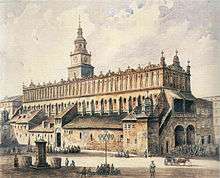
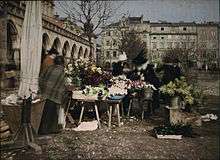
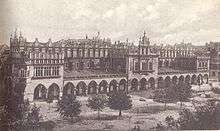
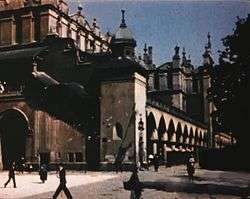

.jpg)
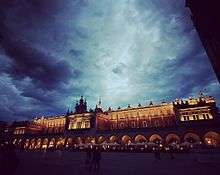
The Cloth Hall (Polish: Sukiennice) in Kraków, Lesser Poland, dates to the Renaissance and is one of the city's most recognizable icons. It is the central feature of the main market square in the Kraków Old Town (listed as a UNESCO World Heritage Site since 1978).
History
It was once a major centre of international trade. Traveling merchants met there to discuss business and to barter. During its golden age in the 15th century, the hall was the source of a variety of exotic imports from the east – spices, silk, leather and wax – while Kraków itself exported textiles, lead, and salt from the Wieliczka Salt Mine.
Other, similar cloth halls have existed in other Polish as well as other European cities such as in Ypres, Belgium; Braunschweig, and in Leeds, England.
Kraków was Poland's capital city and was among the largest cities in Europe already from before the time of the Renaissance. However, its decline started with the move of the capital to Warsaw in the very end of the 16th century. The city's decline was hastened by wars and politics leading to the Partitions of Poland at the end of the 18th century. By the time of the architectural restoration proposed for the cloth hall in 1870 under Austrian rule, much of the historic city center was decrepit. A change in political and economic fortunes for the Kingdom of Galicia and Lodomeria ushered in a revival due to newly established Legislative Assembly or Sejm of the Land. The successful renovation of the Cloth Hall, based on design by Tomasz Pryliński and supervised by Mayor Mikołaj Zyblikiewicz, Sejm Marshal, was one of the most notable achievements of this period.[1]
The hall has hosted many distinguished guests over the centuries and is still used to entertain monarchs and dignitaries, such as Charles, Prince of Wales and Emperor Akihito of Japan, who was welcomed here in 2002. In the past, balls were held here, most notably after Prince Józef Poniatowski had briefly liberated the city from the Austrians in 1809. Aside from its history and cultural value, the hall still is still used as a center of commerce.
In the immediate vicinity of the hall, the Great Weigh House and the Small Weigh House existed until the 19th century.
In 1976, the English band The Who played an "intimate" gig for Polish and British embassy workers, working in Poland.
Upper-floor museum
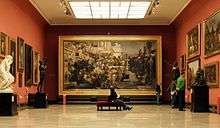
On the upper floor of the hall is the Sukiennice Museum division of the National Museum, Kraków. It holds the largest permanent exhibit of the 19th-century Polish painting and sculpture, in four grand exhibition halls arranged by historical period and the theme extending into an entire artistic epoch.[2] The museum was upgraded in 2010 with new technical equipment, storerooms, service spaces as well as improved thematic layout for the display.
The Gallery of 19th-Century Polish Art was a major cultural venue from the moment it opened on October 7, 1879. It features late Baroque, Rococo, and Classicist 18th-century portraits and battle scenes by Polish and foreign pre-Romantics; the art of partitioned Poland with famed Prussian Homage by Jan Matejko; mythological and biblical scenes with the monumental Nero's Torches by Henryk Siemiradzki, the art of representative members of Young Poland from the turn of the 20th century including Jacek Malczewski, Józef Chełmoński; prominent impressionists Józef Pankiewicz and Leon Wyczółkowski; paintings by Wojciech Gerson and Julian Fałat, as well as large, and controversial Ecstasy, or Frenzy of Exultations by Władysław Podkowiński among other masterpieces.[3]
See also
References
- ↑ Aleksandra Krypczyk (2009). "History of the Gallery in the Sukiennice". About the Museum. National Museum in Krakow. Retrieved November 21, 2012.
- ↑ Aleksandra Krypczyk (2009). "Galeria Sztuki Polskiej XIX wieku w Sukiennicach (Gallery of Polish Art in Sukiennice)". About the museum (in Polish and English). National Museum in Krakow. Retrieved November 26, 2012.
- ↑ National Museum in Krakow (2009). "Sala Chełmońskiego: Realism, Polish Impressionism and Symbolism". Gallery of Polish 19th century art in the Sukiennice (in Polish). Official website. Retrieved November 29, 2012.
External links
![]() Media related to Sukiennice at Wikimedia Commons
Media related to Sukiennice at Wikimedia Commons
- Official Sukiennice museum website
- Sukiennice at www.fodors.com
- Gallery of photos from Sukiennice at www.krakow4u.pl
- Live WebCam